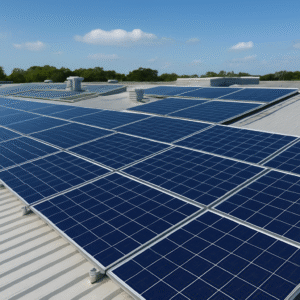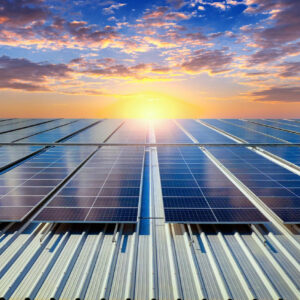
Introduction:
The global energy landscape is undergoing a transformation driven by the growing need for energy independence and sustainability. Distributed energy resources (DERs) and energy storage systems have emerged as key enablers in this journey toward a more decentralized and resilient energy future. This article explores the untapped potential of distributed energy and storage, shedding light on their significance, benefits, challenges, and the path forward.
The Rise of Distributed Energy and Storage:
The traditional paradigm of centralized energy generation is shifting towards a more distributed model. This transition is fueled by the harnessing of renewable sources such as solar and wind energy. The integration of distributed energy resources (DERs) allows for more efficient utilization of renewable energy and reduces reliance on fossil fuels. Additionally, energy storage systems play a pivotal role in capturing surplus energy, ensuring a steady and reliable power supply even when renewable sources are not actively producing electricity.
Advantages of Distributed Energy and Storage:
Distributed energy and storage offer several key advantages. Firstly, they enhance energy resilience by reducing vulnerability to disruptions in the grid. By enabling localized power generation and storage, communities can maintain access to electricity during grid failures or extreme weather events. Secondly, these systems contribute to cost savings by mitigating peak demand charges and optimizing energy usage. Through demand-side management (DSM) strategies, consumers can better manage their energy consumption patterns, leading to reduced costs. Lastly, the environmental impact of distributed energy and storage is significant. By curbing carbon emissions and promoting sustainability, these technologies align with global efforts to combat climate change.
Challenges on the Path to Energy Independence:
Despite the numerous benefits, integrating DERs and energy storage into existing grid infrastructure poses challenges. The harmonious integration of DERs requires careful coordination to ensure grid stability. The technical complexities of managing variable generation and storage capacities demand advanced control systems. Moreover, policy and regulatory frameworks need to be adapted to encourage the widespread adoption of distributed energy solutions.
Unlocking the Potential of Demand-Side Management:
Demand-side management (DSM) is a crucial component of achieving energy independence. DSM empowers consumers through real-time monitoring and control of their energy usage. By optimizing consumption patterns, individuals and businesses can reduce their reliance on the grid and even become energy producers themselves. Integrating DSM with DERs and storage enhances overall system efficiency and flexibility, further contributing to energy independence.
Case Studies: Realizing Energy Independence
Several real-world examples demonstrate the feasibility of energy independence through distributed energy solutions. Germany’s energy transition, known as the Energiewende, showcases the successful integration of distributed energy resources, particularly solar and wind power. Microgrids and off-grid solutions empower remote communities with self-sustaining energy sources. Residential adoption of solar panels and energy storage systems transforms homeowners into energy producers, feeding excess electricity back into the grid.
Future Outlook and Innovations:
Continued technological advancements hold the key to unlocking the full potential of distributed energy and storage. Next-generation energy storage solutions offer higher capacities, longer lifespans, and faster response times. Virtual power plants (VPPs) enable the aggregation of DERs to provide grid support and balance supply and demand. Peer-to-peer energy trading platforms empower consumers to participate in energy markets directly, creating a more decentralized and democratic energy ecosystem.
Overcoming Challenges and Seizing Opportunities:
Collaborative efforts among utilities, governments, and stakeholders are crucial for overcoming challenges and driving adoption. Investment and incentives play a pivotal role in accelerating the deployment of DERs and energy storage. Research and development efforts are necessary to address technical gaps and push the boundaries of innovation in this field.
Towards a Resilient and Sustainable Energy Future:
The journey towards a resilient and sustainable energy future requires a careful balancing act. Integrating DERs while ensuring grid stability is essential for maintaining reliable energy access. Energy democratization, achieved through the widespread adoption of distributed energy solutions, empowers individuals and communities to actively participate in the energy transition. Ultimately, the use of distributed energy and storage technologies paves the way for a cleaner and brighter future, ensuring sustainable energy for generations to come.
Conclusion:
As the world seeks to break free from traditional energy models, the potential of distributed energy resources and storage remains paramount. Empowering energy independence through DERs and storage not only offers economic benefits but also paves the way for a more sustainable and resilient energy future. By addressing challenges, fostering innovation, and promoting collaboration, the transformative power of distributed energy and storage can be fully realized, illuminating the path toward a brighter tomorrow.
Frequently Asked Questions (FAQs)
Q1: What is distributed energy?
A: Distributed energy refers to a decentralized approach to energy generation, where power is produced at or near the point of consumption, allowing individuals and communities to have greater control over their energy production.
Q2: Why is energy independence important?
A: Energy independence offers numerous benefits, including cost savings, enhanced resilience, and reduced carbon emissions. By generating their own power, individuals and communities become less reliant on external energy providers and have the opportunity to embrace renewable energy sources.
Q3: What are some challenges of scaling up distributed energy?
A: Integrating distributed energy systems with existing infrastructure, overcoming financing barriers, and addressing technological limitations are some of the challenges that need to be addressed for the widespread adoption of distributed energy.
Q4: How does distributed energy contribute to environmental sustainability?
A: Distributed energy reduces reliance on finite fossil fuel reserves, mitigates carbon emissions, and helps combat climate change. It also promotes the conservation of natural resources and ensures equitable access to clean and sustainable energy sources.
Q5: What is the future outlook for distributed energy?
A: The future of distributed energy looks promising, with projections indicating significant growth and potential. As renewable energy technologies advance and costs decrease, distributed energy is expected to play a crucial role in meeting global energy demand sustainably.




